
BY BRIAN MUTZABAUGH
Although you may not think you have them in your fire district, hoarders can be anywhere. More than likely, we all have hoarders or hoarding situations in our districts. It is merely a question of when, not if, you will be called to mitigate some type of emergency at one of these dwellings. We should familiarize ourselves with the locations and potential hazards of hoarder dwellings to which we might respond. Equally important, we must look at the amplified problems that can exist at structure fires involving hoarders and examine ways to address these problems early in the incident.
Hoarding is generally considered an excessive accumulation of items kept for future use. Although sometimes a controlled habit, it can also spiral into an overwhelming urge to justify keeping every item encountered, regardless of worth or usefulness. Hoarders will keep anything from inanimate objects such as dolls, containers, newspapers, and clothing to common household trash. Many times, food is also collected based on either the rationale that it never goes bad or “I might eat that one day.” Often, trash and open food containers attract insects and rodents, which breed diseases to which the occupants are exposed.
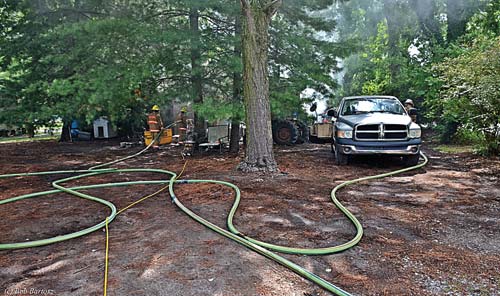 |
| (1) Street view of the A side of the dwelling. The low-hanging branches and overgrown vegetation prevented the first-arriving unit from conducting a windshield size-up, which emphasizes the importance of completing a 360° size-up every time, at every incident. In the foreground are two 1¾-inch hoselines (one attack, one backup) and the yellow electric cord that powered the positive-pressure ventilation fan. (Photos by Bob Bartosz.) |
Hoarders may also keep animals they perceive as strays and rationalize this behavior as rescuing or saving the animals. Although the hoarder may have rescued an animal in some cases, this may eventually lead to the hoarder “rescuing” multiple animals that may end up being neglected. In many cases, animal waste will collect inside the residence because the property owners cannot access areas that need to be cleaned or are simply oblivious to the mess. This is unsanitary not only for the residents but also for us as responders. As we come in contact with the property and its residents, we are exposed to whatever hazards are associated with their living conditions.
Hoarding usually leads to unsanitary living conditions since every available space in a home becomes a storage area. Often, hoarding is linked to people who are suffering from different types of disorders, such as obsessive-compulsive disorder or severe depression. Other times, it can only be explained as a way of living. How it can affect emergency responders is something definitely worth investigating further. We not only have to worry about operating in and around such structures, but we need to consider the emotional and psychological impact on the homeowner, the responders, family members, and even pets. Hoarders generally become very upset when their items are moved or damaged. Although they may admit to having a problem that impacts their daily lives, they are often unwilling to seek help or let go. Even when a fire or natural disaster damages a hoarder’s possessions, that individual may still have serious issues when parting with them because of an emotional attachment. In the hoarders’ minds, they can easily come up with a reason they should keep any item, even if it has been ruined.
 |
| (2) A view along the D side shows several vehicles and a utility trailer blocking the driveway. A guard dog chained to the rear bumper of the trailer forced firefighters to advance a hoseline and move equipment through the row of bushes to the right. |
Described below is a response to a structure fire at a hoarder’s residence and its overall impact on mitigating the incident. Think of the “what ifs,” since this incident could have had a very different ending except for the favorable conditions. We must all learn from the experiences of others.
Fortunately, in this incident, no lives were lost and there were no on-scene emergencies because of the favorable conditions, the well-trained and observant suppression personnel, and a strong command presence. Awareness of the hoarding situation early in the incident allowed responders to develop an effective strategy that kept firefighter safety at the forefront while working to save property and stabilize the incident.
Hoarder Home Fire
On Monday, August 4, 2014, at approximately 1030 hours, units from Nash and Halifax counties in North Carolina were dispatched to a reported working residential structure fire on South White Street in Whitakers. Although a service station attendant across the street on the opposite corner made the initial call, members of the Whitakers Volunteer Fire Department (located on the back side of the same block) had been investigating the origin of smoke in the area.
Nash County Stations 10 (Whitakers), 9 (Battleboro), 18 (Salem), and Halifax County Station 3 (Enfield) were dispatched on the initial alarm. Whitakers and Battleboro have combination departments with two part-time employees working during the weekdays. Salem and Enfield run all-volunteer fire departments. Whitakers Engine 10 arrived on scene and reported a working fire in a single-story residential structure and requested a supply line from the closest hydrant as personnel deployed a 1¾-inch attack line. Whitakers Truck 10 (a pumper/tanker) established a five-inch supply line from a hydrant, and Battleboro Engine 91 deployed a second 1¾-inch backup line from Engine 10 to the Division A side entrance point. As chief (Whitakers Unit 10), I provided the initial radio report and conditions, reporting heavy, turbulent, grayish-brown smoke from Division C and moderate, fast-moving, grayish-brown smoke exiting the Division A gable vents. I established incident command and assigned safety and accountability officers, established a medical group using Nash County emergency medical units, and requested an electrical troubleshooter from the local utility. Enfield Ladder 3 arrived and was staged for deployment if the fire progressed to a defensive operation. Because of numerous past law enforcement responses to the residence (for complaints concerning yard clutter, dogs barking, and reported drug activity), the on-scene local police chief had the residents’ contact information. I requested that the police chief make contact; he was able to confirm with the occupants by phone that no one else was supposed to be inside the structure. The residents were informed of the situation and asked to return to the scene.
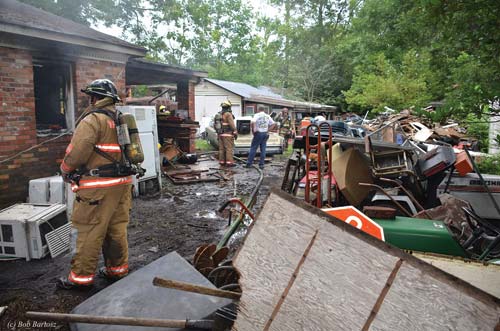 |
| (3) A closer view of the D/C corner where personnel made the transitional attack into the fire room. Waist-high piles of debris in the carport area stopped the crew in an attempt to make the initial push into the dwelling. |
I noted during the 360° size-up that the entire Division A, C, and D exteriors were cluttered with numerous items, including passenger vehicles, machinery, trailers, equipment, and general debris. Fire was also found pushing out the Division C window and door into the carport area. To further complicate matters, the carport area was stacked waist-high with various types of equipment, machinery, and appliances blocking access/egress from this side. Several dogs were also found chained up in various locations around the residence. This initially posed a safety concern since some of the dogs appeared to display a guarding posture by barking and growling at responding personnel. After personnel spoke with the neighbors, the dogs were determined not to be a threat and were safely moved away from the structure. Even though several dogs outside of the residence were saved, three dogs inside perished. These animals were recovered and turned over to the property owner at the conclusion of the incident. This proved emotionally traumatic for the occupants, who were obviously attached to all the animals at the residence.
The fire attack group initially reported that the A side door could not be fully opened because of large amounts of debris and clutter inside the residence. The fire attack group made a transitional attack at the Division C/D corner, allowing personnel to effectively extinguish the bulk of the fire and stop extension into the attic area. Additional personnel had positioned a positive-pressure ventilation fan at the Division A entrance point to support the transition to an interior fire attack. As smoke conditions improved, I was able to look through several exterior windows and noted large piles of debris throughout the structure. Suppression personnel reassembled at the Division A entrance and employed a positive-pressure attack to complete extinguishment, conduct a search, and begin overhaul. As smoke conditions lifted, personnel discerned a visible pathway leading from the front door through piles of various items to the rear hall at the kitchen (Division C/D corner). Fire attack personnel had to find their way through this maze of debris to reach the room of origin at the rear of the structure and complete extinguishment. Additionally, interior doorways were blocked to the point that suppression personnel in personal protective equipment (PPE) and self-contained breathing apparatus (SCBA) had to use force to squeeze through them. This was necessary to check for extension into other rooms and to conduct a search.
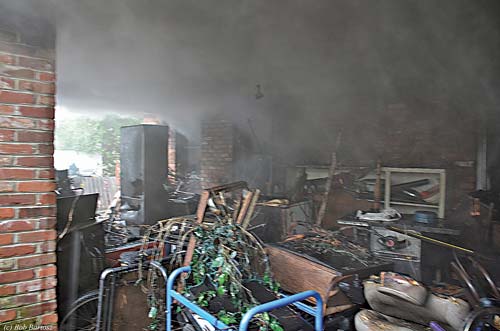 |
| (4) At the C/D corner, an overwhelming amount of debris blocked the window and the door. These conditions could have prevented the occupants from escaping and could have hampered any rescue effort or emergency egress of firefighters. |
When the property owner arrived on scene, I was notified that there were several dogs inside the residence. It was soon apparent that these animals had been inside for quite some time. Suppression personnel later found they had crawled through large amounts of fecal matter and puddles of urine the dogs had left inside the residence when the fire started. This posed another issue, since the turnout gear of personnel conducting fire attack and search had to be removed from service and decontaminated. In many departments nationwide, loaner gear is not available for members whose gear has to be sent off for professional cleaning. Hence, you may have to temporarily take a number of qualified interior firefighters out of service because their PPE is out of service. If your department is like many others around the nation, this is not something you can afford to do. We rely on our members to be ready all the time, and they depend on us to provide them with the equipment needed to do the job.
Once the structure was deemed safe for entry without SCBA, personnel found charring and high-heat indicators approximately three-quarters of the way down the walls in the living room, just inside the Division A entry door. Much of the contents in the living room near the floor level had indications of high-heat exposure, indicating that the room nearly reached flashover. If the attack had not turned to a transitional attack and crews had pushed into the structure, they may have become disoriented when the flashover occurred. Additionally, fire department personnel who forced their way into other rooms to conduct a search or look for extension would be slowed dramatically if they had to execute an emergency egress.
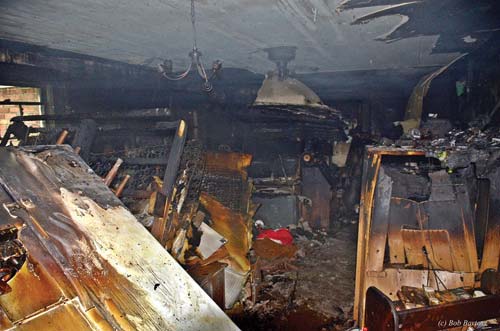 |
| (5) A view through the A side door shows the piles of debris throughout the room. Communicating these conditions immediately to Command resulted in a change of strategy to an aggressive defensive attack from the D/C corner. Next, a ventilation fan was placed in service at the A side entrance prior to personnel moving back into the structure for extinguishment. The refrigerator to the left was partially behind the door and had to be knocked over to gain entry. |
Remember that in hoarder homes, often the windows may not be visible from the interior and may be hard to access because of the piles of debris. Interior personnel should take extra precautions to remain oriented in these types of structures.
Also keep in mind that rooms with inward-swinging doors blocked by debris will generally be easier to enter than to exit. When entering, firefighters have the advantage of using their entire body weight to push on the door, forcing the debris out of the way. But as they try to exit from the room through the same door, they could be limited to using only upper body strength to pull the door open.
They may also find that debris shifting behind the door on entry places a larger load when exiting. If you can only partially open the door, remember that you may have to use a reduced profile maneuver to make yourself as small as possible. You can accomplish this in several ways, including placing your SCBA on the side of your body or removing and pushing the SCBA ahead of you through the diminished clearance opening. Personnel on the exterior should ensure that all other doorways and windows are clear on the outside, giving interior crews a clear exit path.
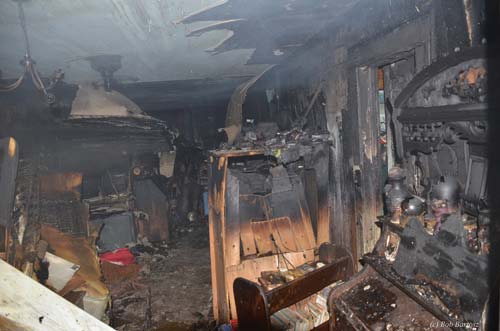 |
| (6) At the A side door, notice the pathway to the rear of the dwelling that firefighters had to navigate. Imagine doing this without effective ventilation and the risk of debris piles collapsing on personnel as they attempted to make their way through. This is also where interior crews unknowingly crawled through feces left by the numerous dogs on and inside the property. These conditions were found in all interior rooms. Note that behind the door along the right wall there is debris piled up to the ceiling. |
There is no doubt that the time of this incident (daytime) proved advantageous to a safe, successful operation. If this incident had occurred at night with little to no visibility, suppression personnel would have stood a much higher chance of injury just maneuvering around the exterior. A limited visibility incident coupled with the hoarding would have adversely affected the personal safety for all responders and potentially increased property loss.
Having confirmed early on that all occupants were accounted for eliminated the need for an immediate interior victim search. Yet, had firefighters initiated an immediate victim search, it certainly would have placed response personnel at a greater risk of disorientation or entanglement because of the unusually large amount of debris and clutter inside the home.
Knocking down the fire from the exterior, or “softening the target,” and following with a positive-pressure attack allowed us to save approximately 60 percent of the structure. Had the fire had a more central location inside the structure, extension into other rooms or the attic could have been more prevalent, which would have resulted in a larger loss of property or a fatality if suppression personnel were unable to access a victim. Although it took nearly 45 minutes for the fire to be fully extinguished and brought under control, the transitional attack slowed the fire’s growth, keeping it in the room of origin, and allowed response personnel to remain on strategy throughout the incident.
Fire service personnel should prepare for hoarding scenarios with as much proactive preplanning as possible. Remember, a working fire inside a hoarding structure is comparable to fighting a fire inside a junkyard that is contained within a building.
Emergency services personnel need to remember that customers cherish every object they possess, regardless of how others may evaluate it. The inability to let go of items or deem them as garbage leads to hoarding. Hoarders expect and deserve that we give as much consideration and care to their belongings as to those of other citizens we serve. However, we must always remember that while contents and property are important, they never outweigh the safety of responders. We should never risk the injury or death of a firefighter to save property or contents alone.
Although we may initially think we have arrived at a simple room-and-contents fire in a residential dwelling, the problems associated with hoarding can trigger many unexpected problems. We must keep in mind the larger-than-ordinary fuel loads present in hoarding situations and the increased fire growth rate. Increased floor weight, high-piled/unstable storage, higher heat release rates, and the increase of toxic and flammable gases are just a few other concerns to keep in mind when dealing with these types of incidents. These types of structures quickly become unorganized and difficult to navigate because of the limited amount of storage space and numerous items hoarded. Exterior conditions may not provide adequate clues to inside conditions, leaving firefighters to believe the structure’s layout and contents are “average” or “normal.” There is nothing normal or routine when response personnel are operating around and inside these types of structures and attempting to weave through the entangling debris around them. The chances for injury to suppression personnel are greatly increased if extra caution is not used.
Make every attempt during the 360° size-up to identify signs of hoarding, such as the amount of debris outside the structure, as was encountered on this incident. Since we had never responded to this address, the interior conditions were a surprise. Take a brief look through exterior windows to determine whether what’s inside is well worth the time and effort. Signs of hoarding on the exterior should prepare you for conditions to be far worse on the inside.
Responding to incidents involving hoarders at night or in extremely low-light conditions should prompt incident commanders to deploy adequate scene lighting as early as possible. Although this may initially delay deployment of fire streams into or on the structure, it will provide a safer working environment around the structure.
If animals are present, notify all responding personnel, and exercise extreme caution. You may have to request local animal control to assist in removing and securing animals at the incident. Have the homeowner locate and secure all pets since the animals will be less likely to become aggressive toward their owner.
Afterward, we must take care of our personnel and equipment prior to leaving the scene if at all possible. Remember, we have basically responded to a structure fire involving hazardous materials. In addition to the types of items kept in these structures and the possibility of varying types of stored chemicals, there is the possibility of encountering animal or human waste. At a minimum, all personnel who entered the structure should receive a quick washdown of their PPE with a brush, soap, and water while on scene.
After returning to the station, the PPE and equipment should be disinfected following the manufacturer’s guidelines. This may include having turnout gear sent out for professional cleaning and sanitizing.
Fire service leadership should also complete any necessary paperwork documenting the exposure of personnel to all known materials, chemicals, or fluids. If volunteers or call-back personnel responded by personally owned vehicles, do not allow these members to place the PPE in their vehicles or return home prior to decontaminating the PPE.
Calling in a haz-mat or decontamination company from your department or a nearby agency is beneficial here. Such units are often well equipped to handle the decontamination of suppression personnel and equipment as well as assist with mitigating the incident.
Your agency may not regularly handle emergency incidents involving hoarders or may not have ever responded to one. That is all the more reason to review the hazards associated with hoarding with your department’s personnel. Sit down and collectively determine if there are known hoarders in your district and then develop a plan as to how you would address an emergency at these locations. If you don’t have the resources you need within your department, talk with your automatic and mutual-aid companies and identify what resources are available that may be beneficial for such events.
Remember, the residents of these properties deserve the same level of care and compassion as anyone else. However, because of the overwhelming number of items they have, you may have to give special consideration to salvage operations.
Don’t commit suppression personnel to the interior of a hoarder’s residence without taking the extra precautions to ensure their safety. Attack from the exterior initially, ventilate prior to entry, use all available sources of lighting both inside and outside of the structure, and decontaminate your people and equipment afterward. Also, prepare for firefighters to become frustrated with the large amounts of debris hampering their efforts. Be patient with the lack of progress, since moving slowly will limit injuries in working around and into the structure.
Focus on the overall outcome that all of our personnel safely complete the task assigned them every day. As leaders, we must always strive to deliver our personnel back to their families the same way they left for the start of their shift. We owe it to our members and ourselves to put our members’ safety at the forefront in each decision we make.
BRIAN MUTZABAUGH is a 19-year veteran of the fire service and, since 2011, chief of the Whitakers (NC) Volunteer Fire Department. He is also an engineer with the Rocky Mount Fire Department, assigned to Rescue 2. He is a qualified level 2 instructor with the North Carolina Department of Insurance, Office of the State Fire Marshal and is a fire service instructor for Nash Community College.
First-Due Battalion Chief: Collyer’s Mansions
Hoarding : A Fire Prevention and Response Concern
Hoarder House Fire

